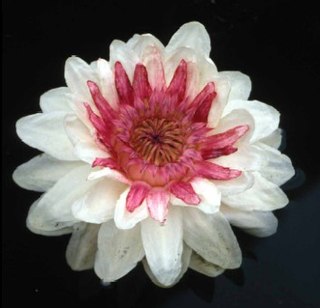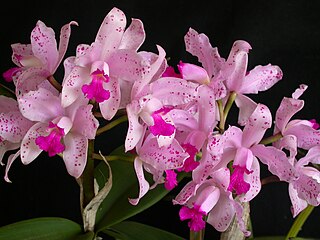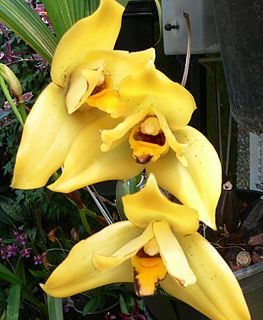
Cattleya is a genus of orchids from Costa Rica south to Argentina. The genus is abbreviated C in trade journals.

The Flora of Colombia is characterized by 130,000 species of plants that have been described within Colombian territory.
This page lists orchid species according to their respective distribution range.

Cattleya amethystoglossa is a bifoliate species of orchid from the genus Cattleya.

The term grex, derived from the Latin noun grex, gregis, meaning 'flock', has been expanded in botanical nomenclature to describe hybrids of orchids, based solely on their parentage. Grex names are one of the three categories of plant names governed by the International Code of Nomenclature for Cultivated Plants; within a grex the cultivar group category can be used to refer to plants by their shared characteristics, and individual orchid plants can be selected and named as cultivars.

Cattleya dormaniana, or Dorman's cattleya, is a bifoliate Cattleya species of orchid. The diploid chromosome number of C. dormaniana has been determined as 2n = 40.

Cattleya dowiana is a species of orchid. The diploid chromosome number of C. dowiana has been determined as 2n = 40; the haploid chromosome number has been determined as n = 20.

Cattleya forbesii, or Forbes' cattleya, is a species of orchid. The diploid chromosome number of C. forbesii has been determined as 2n = 54–60.

Cattleya granulosa is a bifoliate Cattleya species of orchid. It is endemic to Brazil; the type specimen was reported to come from Guatemala, but this is likely erroneous. The diploid chromosome number of C. granulosa has been determined as 2n = 40.

Cattleya guttata is a bifoliate Cattleya species of orchid. The diploid chromosome number of C. guttata has been determined as 2n = 40.

Cattleya intermedia, the intermediate cattleya, is a bifoliate Cattleya species of orchid. The diploid chromosome number of C. intermedia has been determined as 2n = 40.

Cattleya lawrenceana is a species of labiate Cattleya orchid.

Cattleya mossiae, commonly known as easter orchid, is a species of labiate Cattleya orchid. The white-flowered form is sometimes known as Cattleya wagneri. The diploid chromosome number of C. mossiae has been determined as 2n = 40. The haploid chromosome number has been determined as n = 20.

Cattleya nobilior is a species of orchid. The rhizanthoid Cattleyas differ from the other species of Cattleya by having inflorescences which arise directly from the rhizome, instead of from the apex of the pseudobulb. The diploid chromosome number of C. nobilior has been determined as 2n = 42, which contrasts with the value of 2n = 40 for C. walkeriana.

Cattleya schilleriana is a species of bifoliate Cattleya orchid.

Cattleya violacea is a species of orchid native to the lowland rainforests of the Amazon and Orinoco river basins, being the most widespread of all Cattleya species in the wild. Orchids of this species grow on trees along rivers, as they require heat and moisture year round.

Cattleya warscewiczii, a labiate Cattleya, is a species of orchid.

Cattleya crispa is a species of orchid indigenous to the Tijuca Mountains north of Rio de Janeiro, Brazil, noted for its crisped and ruffled petals and lip. It is the type species for both the subgenus Cattleya subg. Crispae and its section Cattleya sect. Crispae.

Cattleya elongata, the "cattleya with the elongated stalk", is an orchid species in the genus Cattleya endemic to the campo rupestre vegetation in northeastern Brazil.

Cattleya × elegans is a hybrid orchid in the subtribe Laeliinae. It is a pseudobulb epiphyte. Its formula hybridae is Cattleya purpurata Van den Berg (2008) × Cattleya tigrina A.Rich. (1848). It is found in South and South-East Brazil.



















